Taminul Islam
GasTwinFormer: A Hybrid Vision Transformer for Livestock Methane Emission Segmentation and Dietary Classification in Optical Gas Imaging
Aug 20, 2025Abstract:Livestock methane emissions represent 32% of human-caused methane production, making automated monitoring critical for climate mitigation strategies. We introduce GasTwinFormer, a hybrid vision transformer for real-time methane emission segmentation and dietary classification in optical gas imaging through a novel Mix Twin encoder alternating between spatially-reduced global attention and locally-grouped attention mechanisms. Our architecture incorporates a lightweight LR-ASPP decoder for multi-scale feature aggregation and enables simultaneous methane segmentation and dietary classification in a unified framework. We contribute the first comprehensive beef cattle methane emission dataset using OGI, containing 11,694 annotated frames across three dietary treatments. GasTwinFormer achieves 74.47% mIoU and 83.63% mF1 for segmentation while maintaining exceptional efficiency with only 3.348M parameters, 3.428G FLOPs, and 114.9 FPS inference speed. Additionally, our method achieves perfect dietary classification accuracy (100%), demonstrating the effectiveness of leveraging diet-emission correlations. Extensive ablation studies validate each architectural component, establishing GasTwinFormer as a practical solution for real-time livestock emission monitoring. Please see our project page at gastwinformer.github.io.
WeedSense: Multi-Task Learning for Weed Segmentation, Height Estimation, and Growth Stage Classification
Aug 20, 2025Abstract:Weed management represents a critical challenge in agriculture, significantly impacting crop yields and requiring substantial resources for control. Effective weed monitoring and analysis strategies are crucial for implementing sustainable agricultural practices and site-specific management approaches. We introduce WeedSense, a novel multi-task learning architecture for comprehensive weed analysis that jointly performs semantic segmentation, height estimation, and growth stage classification. We present a unique dataset capturing 16 weed species over an 11-week growth cycle with pixel-level annotations, height measurements, and temporal labels. WeedSense leverages a dual-path encoder incorporating Universal Inverted Bottleneck blocks and a Multi-Task Bifurcated Decoder with transformer-based feature fusion to generate multi-scale features and enable simultaneous prediction across multiple tasks. WeedSense outperforms other state-of-the-art models on our comprehensive evaluation. On our multi-task dataset, WeedSense achieves mIoU of 89.78% for segmentation, 1.67cm MAE for height estimation, and 99.99% accuracy for growth stage classification while maintaining real-time inference at 160 FPS. Our multitask approach achieves 3$\times$ faster inference than sequential single-task execution and uses 32.4% fewer parameters. Please see our project page at weedsense.github.io.
Predictive Modeling for Breast Cancer Classification in the Context of Bangladeshi Patients: A Supervised Machine Learning Approach with Explainable AI
Apr 06, 2024Abstract:Breast cancer has rapidly increased in prevalence in recent years, making it one of the leading causes of mortality worldwide. Among all cancers, it is by far the most common. Diagnosing this illness manually requires significant time and expertise. Since detecting breast cancer is a time-consuming process, preventing its further spread can be aided by creating machine-based forecasts. Machine learning and Explainable AI are crucial in classification as they not only provide accurate predictions but also offer insights into how the model arrives at its decisions, aiding in the understanding and trustworthiness of the classification results. In this study, we evaluate and compare the classification accuracy, precision, recall, and F-1 scores of five different machine learning methods using a primary dataset (500 patients from Dhaka Medical College Hospital). Five different supervised machine learning techniques, including decision tree, random forest, logistic regression, naive bayes, and XGBoost, have been used to achieve optimal results on our dataset. Additionally, this study applied SHAP analysis to the XGBoost model to interpret the model's predictions and understand the impact of each feature on the model's output. We compared the accuracy with which several algorithms classified the data, as well as contrasted with other literature in this field. After final evaluation, this study found that XGBoost achieved the best model accuracy, which is 97%.
Enhancing Bangla Fake News Detection Using Bidirectional Gated Recurrent Units and Deep Learning Techniques
Mar 31, 2024Abstract:The rise of fake news has made the need for effective detection methods, including in languages other than English, increasingly important. The study aims to address the challenges of Bangla which is considered a less important language. To this end, a complete dataset containing about 50,000 news items is proposed. Several deep learning models have been tested on this dataset, including the bidirectional gated recurrent unit (GRU), the long short-term memory (LSTM), the 1D convolutional neural network (CNN), and hybrid architectures. For this research, we assessed the efficacy of the model utilizing a range of useful measures, including recall, precision, F1 score, and accuracy. This was done by employing a big application. We carry out comprehensive trials to show the effectiveness of these models in identifying bogus news in Bangla, with the Bidirectional GRU model having a stunning accuracy of 99.16%. Our analysis highlights the importance of dataset balance and the need for continual improvement efforts to a substantial degree. This study makes a major contribution to the creation of Bangla fake news detecting systems with limited resources, thereby setting the stage for future improvements in the detection process.
Cannabis Seed Variant Detection using Faster R-CNN
Mar 15, 2024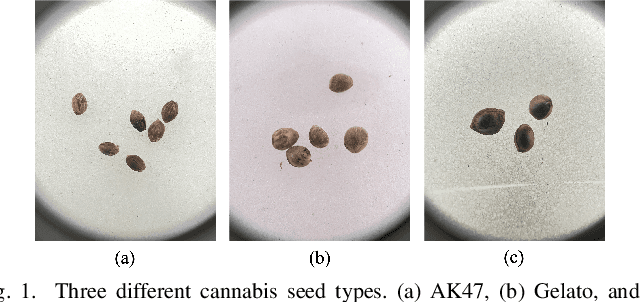
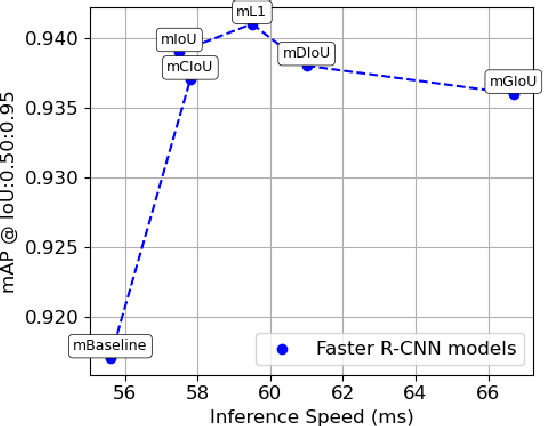

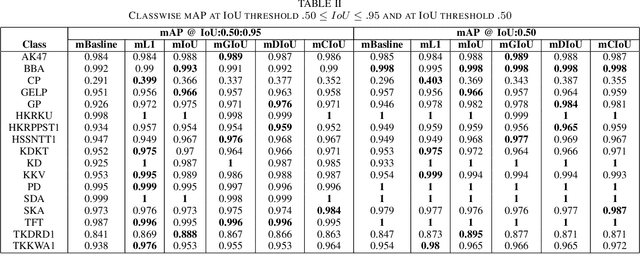
Abstract:Analyzing and detecting cannabis seed variants is crucial for the agriculture industry. It enables precision breeding, allowing cultivators to selectively enhance desirable traits. Accurate identification of seed variants also ensures regulatory compliance, facilitating the cultivation of specific cannabis strains with defined characteristics, ultimately improving agricultural productivity and meeting diverse market demands. This paper presents a study on cannabis seed variant detection by employing a state-of-the-art object detection model Faster R-CNN. This study implemented the model on a locally sourced cannabis seed dataset in Thailand, comprising 17 distinct classes. We evaluate six Faster R-CNN models by comparing performance on various metrics and achieving a mAP score of 94.08\% and an F1 score of 95.66\%. This paper presents the first known application of deep neural network object detection models to the novel task of visually identifying cannabis seed types.
Machine Learning Approach on Multiclass Classification of Internet Firewall Log Files
Jun 12, 2023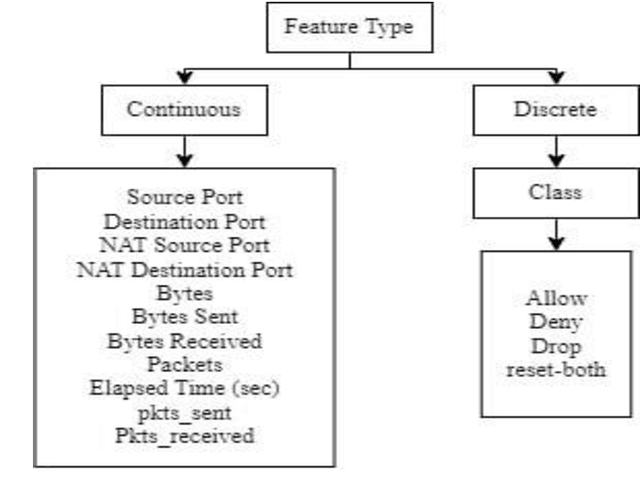
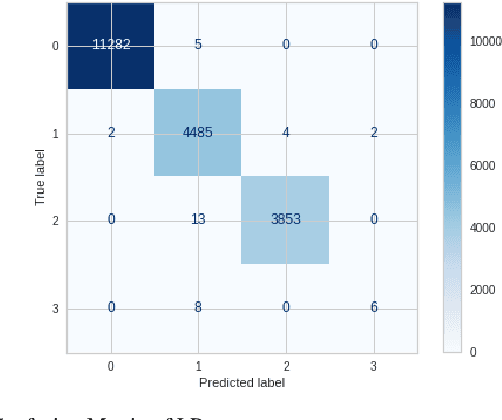
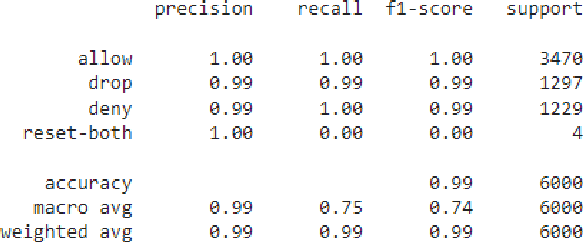
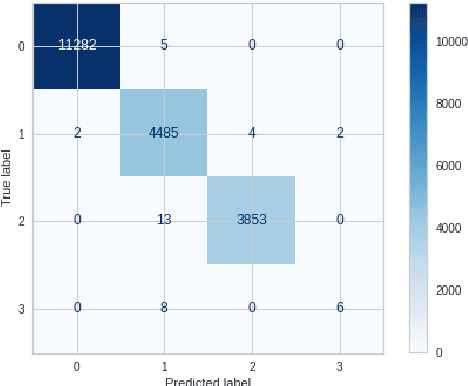
Abstract:Firewalls are critical components in securing communication networks by screening all incoming (and occasionally exiting) data packets. Filtering is carried out by comparing incoming data packets to a set of rules designed to prevent malicious code from entering the network. To regulate the flow of data packets entering and leaving a network, an Internet firewall keeps a track of all activity. While the primary function of log files is to aid in troubleshooting and diagnostics, the information they contain is also very relevant to system audits and forensics. Firewalls primary function is to prevent malicious data packets from being sent. In order to better defend against cyberattacks and understand when and how malicious actions are influencing the internet, it is necessary to examine log files. As a result, the firewall decides whether to 'allow,' 'deny,' 'drop,' or 'reset-both' the incoming and outgoing packets. In this research, we apply various categorization algorithms to make sense of data logged by a firewall device. Harmonic mean F1 score, recall, and sensitivity measurement data with a 99% accuracy score in the random forest technique are used to compare the classifier's performance. To be sure, the proposed characteristics did significantly contribute to enhancing the firewall classification rate, as seen by the high accuracy rates generated by the other methods.
Analysis of Arrhythmia Classification on ECG Dataset
Jan 10, 2023Abstract:The heart is one of the most vital organs in the human body. It supplies blood and nutrients in other parts of the body. Therefore, maintaining a healthy heart is essential. As a heart disorder, arrhythmia is a condition in which the heart's pumping mechanism becomes aberrant. The Electrocardiogram is used to analyze the arrhythmia problem from the ECG signals because of its fewer difficulties and cheapness. The heart peaks shown in the ECG graph are used to detect heart diseases, and the R peak is used to analyze arrhythmia disease. Arrhythmia is grouped into two groups - Tachycardia and Bradycardia for detection. In this paper, we discussed many different techniques such as Deep CNNs, LSTM, SVM, NN classifier, Wavelet, TQWT, etc., that have been used for detecting arrhythmia using various datasets throughout the previous decade. This work shows the analysis of some arrhythmia classification on the ECG dataset. Here, Data preprocessing, feature extraction, classification processes were applied on most research work and achieved better performance for classifying ECG signals to detect arrhythmia. Automatic arrhythmia detection can help cardiologists make the right decisions immediately to save human life. In addition, this research presents various previous research limitations with some challenges in detecting arrhythmia that will help in future research.
* 6 pages, 5 figures. This paper has been published to 2022 proceedings of IEEE 7th International conference for Convergence in Technology (I2CT), 07-09 April 2022, Mumbai, India
Machine Learning Approaches to Predict Breast Cancer: Bangladesh Perspective
Jun 30, 2022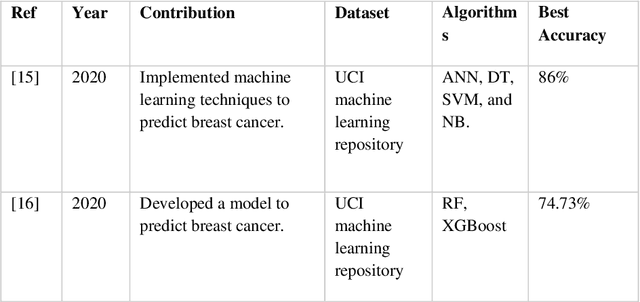
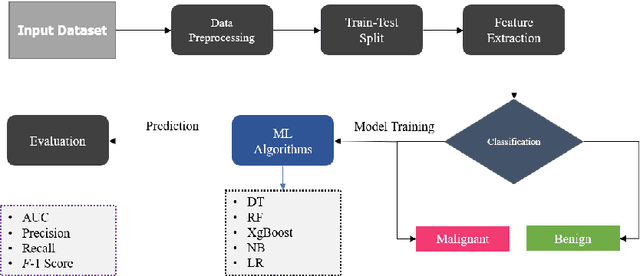
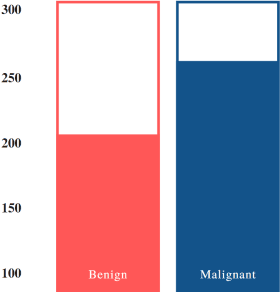
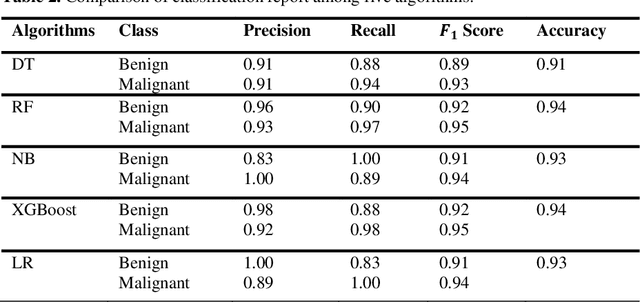
Abstract:Nowadays, Breast cancer has risen to become one of the most prominent causes of death in recent years. Among all malignancies, this is the most frequent and the major cause of death for women globally. Manually diagnosing this disease requires a good amount of time and expertise. Breast cancer detection is time-consuming, and the spread of the disease can be reduced by developing machine-based breast cancer predictions. In Machine learning, the system can learn from prior instances and find hard-to-detect patterns from noisy or complicated data sets using various statistical, probabilistic, and optimization approaches. This work compares several machine learning algorithm's classification accuracy, precision, sensitivity, and specificity on a newly collected dataset. In this work Decision tree, Random Forest, Logistic Regression, Naive Bayes, and XGBoost, these five machine learning approaches have been implemented to get the best performance on our dataset. This study focuses on finding the best algorithm that can forecast breast cancer with maximum accuracy in terms of its classes. This work evaluated the quality of each algorithm's data classification in terms of efficiency and effectiveness. And also compared with other published work on this domain. After implementing the model, this study achieved the best model accuracy, 94% on Random Forest and XGBoost.
Convolutional Neural Network Based Partial Face Detection
Jun 29, 2022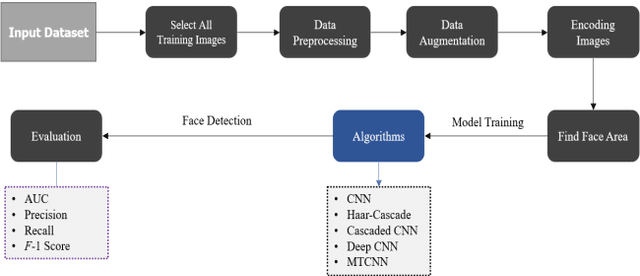

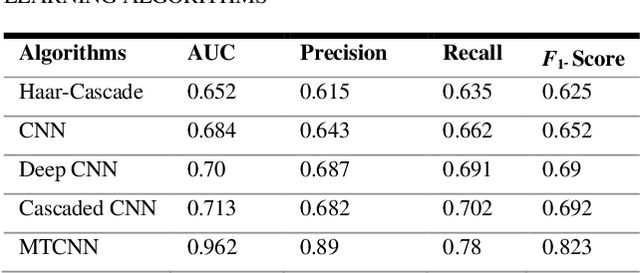

Abstract:Due to the massive explanation of artificial intelligence, machine learning technology is being used in various areas of our day-to-day life. In the world, there are a lot of scenarios where a simple crime can be prevented before it may even happen or find the person responsible for it. A face is one distinctive feature that we have and can differentiate easily among many other species. But not just different species, it also plays a significant role in determining someone from the same species as us, humans. Regarding this critical feature, a single problem occurs most often nowadays. When the camera is pointed, it cannot detect a person's face, and it becomes a poor image. On the other hand, where there was a robbery and a security camera installed, the robber's identity is almost indistinguishable due to the low-quality camera. But just making an excellent algorithm to work and detecting a face reduces the cost of hardware, and it doesn't cost that much to focus on that area. Facial recognition, widget control, and such can be done by detecting the face correctly. This study aims to create and enhance a machine learning model that correctly recognizes faces. Total 627 Data have been collected from different Bangladeshi people's faces on four angels. In this work, CNN, Harr Cascade, Cascaded CNN, Deep CNN & MTCNN are these five machine learning approaches implemented to get the best accuracy of our dataset. After creating and running the model, Multi-Task Convolutional Neural Network (MTCNN) achieved 96.2% best model accuracy with training data rather than other machine learning models.
 Add to Chrome
Add to Chrome Add to Firefox
Add to Firefox Add to Edge
Add to Edge